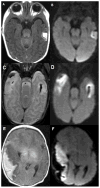Neonatal Vein of Labbé Infarction Size is Associated With Long-Term Language Outcomes
- PMID: 28495146
- PMCID: PMC5480620
- DOI: 10.1016/j.pediatrneurol.2017.03.015
Neonatal Vein of Labbé Infarction Size is Associated With Long-Term Language Outcomes
Abstract
Background: The vein of Labbé is a superficial cortical vein, which drains the lateral surface of the temporal lobe. Thrombosis of the vein of Labbé can occur in the neonatal period. The developmental outcomes of infants who had vein of Labbé thrombosis are unknown as few studies of outcomes exist.
Methods: We completed a retrospective review of infants born ≥34 weeks of gestation, diagnosed with vein of Labbé thrombosis, and/or infarction on neuroimaging during the first 30 days of life. Size of each temporal lobe infarction was estimated based on the number of temporal lobe segments involved. Primary outcomes were the presence of major neurodevelopmental impairments in childhood and Bayley scores at two years.
Results: Our cohort of 19 infants had a median gestational age of 38 weeks (interquartile range 36 to 39) and mean birth weight 2892 ± 920 grams. The most common presenting symptoms of vein of Labbé thrombosis and infarction of surrounding tissue were seizures, apnea, lethargy, and either hypertonia or hypotonia. At the latest clinical follow-up appointment documented in the electronic medical record (mean 4.4 ± 3.08 years), 44% had major neurodevelopmental impairment. Patients with large vein of Labbé infarctions had significantly worse average Bayley scores than those with small to moderate lesions, and differences in language composite were statistically significant (72.7 vs 107.8, P = 0.017).
Conclusions: Neonates with large vein of Labbé infarctions are more likely to have poor language outcomes. This finding suggests a need for targeted surveillance to ensure early identification of deficits and referral for intervention.
Keywords: cerebral sinovenous thrombosis; neonate; neurodevelopment; outcome; vein of Labbé.
Copyright © 2017 Elsevier Inc. All rights reserved.
Conflict of interest statement
Conflicts of interest: none
Figures

References
MeSH terms
Grants and funding
LinkOut - more resources
Full Text Sources
Other Literature Sources
Medical

